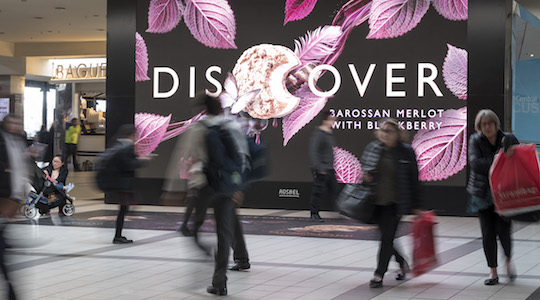Own the journey: how to win the hearts and minds of Australian commuters
Share
Australia’s population is booming, and our urban footprint continues to spread at pace. Adshel CEO Mike Tyquin explains how the daily commute offers brands a unique opportunity to reach, prime and influence commuters with small format out-of-home advertising – owning the journey, not just the destination.
This article was sponsored by Adshel to let readers know about its new ‘Own the Journey, Not Just the Destination’ commuter study »
 Australia’s population reached 25 million in August, more than two decades ahead of schedule according to previous forecasting. At the current rate of growth, our population will reach 30 million by 2030. That’s an astonishing rate of population growth, and the way we commute across our cities has changed significantly as a result.
Australia’s population reached 25 million in August, more than two decades ahead of schedule according to previous forecasting. At the current rate of growth, our population will reach 30 million by 2030. That’s an astonishing rate of population growth, and the way we commute across our cities has changed significantly as a result.
People are moving further out from central hubs. Areas once considered ‘rural’ have become mid-suburbia, and no one blinks an eye at the need to travel long distances every day to get to and from work. The payoff, of course, being a house and backyard of your own… white picket fence optional.
It is these population changes – particularly the fact that the distance between home and work has increased significantly – that prompted us to delve deeper into what millions of Australian commuters are thinking and feeling, what they’re doing, and how they’re interacting with advertising during their daily journey to work or study.
We wanted to gain greater insight into the typical Australian commuter’s experience so we could help brands and advertisers maximise their exposure and influence during the journey. In a research project that encompassed ethnographic ‘mid-commute’ face-to-face interviews, the study of a collection of commuter video diaries and a quantitative online survey, we uncovered some fascinating and surprising insights into the mood and mindset of Australian commuters.
The mood and mindset of Australian commuters
Our research showed that – contrary to popular internet memes and what most of us might automatically assume – for the most part, commuters don’t mind their daily commute, with only 16% actively disliking it.
As Dr David Bissell, Associate Professor and ARC Future Fellow at University of Melbourne says in his book Transit Life, “Commuting can tire, deplete and cost, but it can also enliven, excite and energise.”
While people are travelling for longer periods – the average daily commute is now between 60-72 minutes – they’ve reframed that time as a positive ‘transition time’ between the often-tense morning routine of home (think: packing lunches, finding socks and getting everyone out the door) and the professional pressures and stresses of work.
Continues Dr Bissell, “Both poison and cure, the commute is a zone in which the tensions and contradictions, the diverse influences and desires that are our lives, come to the fore.”
The daily commute has become that magical commodity we all value – precious ‘me time’, where we have the chance to just sit, catch up on emails and socials, listen to music, or start to research our next dream holiday destination or big-ticket item.
Key findings of Adshel’s ‘Own the Journey, Not Just the Destination’ commuter study
- Australians now spend 60 – 72 minutes each day commuting, which is the equivalent of 288 hours, or 36 work days each year,
- Metro commuters take an average of two different modes of transport to work/study each day,
- A commute of 30-45 minutes each way is the ‘sweet spot’, where commuters are most likely to enjoy their journey and be more open and receptive to messaging,
- Time spent commuting has increased 33% in the five years from 2013 to 2018,
- 75% of commuters see their commute as either ‘doing time’ or ‘down time,’ and
- 84% feel either positive or neutral about their daily commute, with only 16% actively disliking it.
This positive mindset experienced during the daily commute results in people feeling more alert, open and receptive to new ideas and messages – the perfect time for brands to reach, prime and influence their target audience.
What is ‘priming’ and how can I use it?
‘Priming’ is a psychological phenomenon that refers to the way in which we are all subtly impacted by everything in our environment, from sounds to pictures, smells and texts, that can sub-consciously affect how we think, feel and behave. Priming explains how our brains categorise information – whether it’s useful, interesting or potentially important – and can play a vital role in advertising.
As neuromarketing expert and founder and principal of Neurothinkers, Dr Peter Steidl explains, “Priming can have a major impact on our short-term decision making and can be enormously important in making us more receptive to certain choices. Journeys, and especially the daily commute, are a very effective time for this priming effect. The out-of-home advertising that commuters see along their journey creates memories that then become a trigger at the point of purchase.”
What this means for brands and advertisers
Our ‘Own the Journey, Not Just the Destination’ report has identified that small format out-of-home advertising can be a powerful medium, cutting through clutter and reaching people when they’re most receptive to new ideas and messages.
Perception of advertising: Commuters see out-of-home advertising as less intrusive and annoying, and more trustworthy than online, TV and radio advertising.
Our research also identified that the most powerful use of out-of-home advertising is in delivering simple key messages without overwhelming audiences with too much information – the ideal format is short, sharp, eye-catching, attention-grabbing, inspirational and aspirational messages that are delivered in a non-intrusive way.
Effective use of small format out-of-home advertising can lead to people researching further or even making on-the-spot decisions to buy. “When you’re on a journey, small format out-of-home advertising isn’t intrusive; it doesn’t interrupt what you’re doing or planning to do,” says Dr Steidl. “That’s what gives this type of advertising such a big advantage over other ad formats. When a person is interrupted by advertising, when their goal is interfered with – like an ad interrupting their favourite TV show – they can feel resentful towards that ad, or that brand. But on the daily commute, the out-of-home ad doesn’t interrupt. It’s just there. So people are more receptive to it.”
Of course, not all commuters feel positive and receptive to messaging all the time, and the research shows that – unsurprisingly – people are more likely to feel positive, refreshed and receptive on their morning journey to work, as compared to their evening trip home. We also identified that different types of creative approaches will also be more effective at different times of the day, all dependent on the mindset of the commuter.
Understanding commuters is one of our core objectives, and previous research we’ve undertaken has even identified specific time periods when commuters are more likely to consider, research and compare prices for products across varying industries. This detailed research can give your campaign pinpoint accuracy when it comes to effectively targeting your audience in the right place at the right time.
Mike Tyquin is Adshel CEO.
Learn more about how out-of-advertising can help you to effectively reach, prime and influence your target audience – download the ‘Own the Journey’ commuter study »
Adshel has more than 17,500 touchpoints and a 90x frequency every fortnight to reach your audience. Having these touchpoints throughout the entire journey, not just at the destination, allows brands to engage, prime and influence people when they’re at their most receptive. For more fascinating insights into the mood and mindsight of the Australian commuter, or to find out how out-of-home advertising could benefit your clients, get in touch with Adshel today.

















